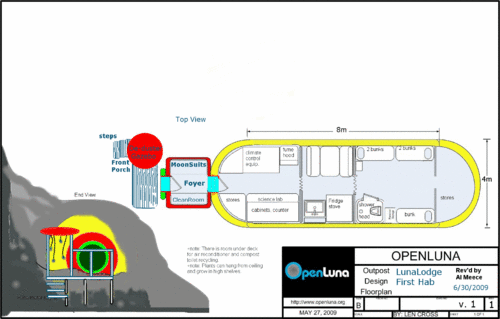Difference between revisions of "Habitat"
(adding category) |
Navigaiter (talk | contribs) (added hab image.) |
||
| Line 1: | Line 1: | ||
| − | + | '''FIRST STAGE HABITAT''' | |
| + | --[[User:Navigaiter|Navigaiter]] 02:23, 8 July 2009 (UTC)Here is my drawing [I did for the OpenLuna Wiki] for a ProtoHab supporting up to five crew on Luna. [[User:Navigaiter|Navigaiter]] Comments??? Lemme see if there's some life here. Click image for blowup. | ||
| + | [[Image:LunaLodge1 OpenLuna.gif|thumb|500px]] | ||
| + | |||
| + | |||
| + | |||
| + | |||
| + | ---- | ||
| + | |||
| + | ---- | ||
| + | |||
| + | '''THIRD STAGE HABITAT''' | ||
| + | |||
| + | Tunnel bored habitat (TB-habitat) - Artificial cave | ||
A TB-habitat is a habitat constructed using a tunnel boring machine (TBM). A TBM will have to be specifically designed for this purpose taking weight into account, as it has to be lifted from the Earth’s surface and landed on the lunar surface. This will diminish its cutting diameter. | A TB-habitat is a habitat constructed using a tunnel boring machine (TBM). A TBM will have to be specifically designed for this purpose taking weight into account, as it has to be lifted from the Earth’s surface and landed on the lunar surface. This will diminish its cutting diameter. | ||
Revision as of 18:23, 7 July 2009
FIRST STAGE HABITAT
--Navigaiter 02:23, 8 July 2009 (UTC)Here is my drawing [I did for the OpenLuna Wiki] for a ProtoHab supporting up to five crew on Luna. Navigaiter Comments??? Lemme see if there's some life here. Click image for blowup.
THIRD STAGE HABITAT
Tunnel bored habitat (TB-habitat) - Artificial cave A TB-habitat is a habitat constructed using a tunnel boring machine (TBM). A TBM will have to be specifically designed for this purpose taking weight into account, as it has to be lifted from the Earth’s surface and landed on the lunar surface. This will diminish its cutting diameter.
This type of habitat is a 'third stage' habitat, as opposed to the habitat that will be used by the first party that lands on the Moon. That habitat would be categorized as a 'first stage' habitat. And when a permanent ('second stage') settlement has been build, TB-habitats are to be used to expand the settlement quickly and inexpensively.
The approach would be, to drill a grid of intersecting tunnels, each closed of at the ends by a air tight wall or, on occasion, an airlock. Within this grid, sections can be closed of with non-load-bearing walls creating dormitory rooms, workspaces, technical facilities, labs, social hubs, underground greenhouses, and so on.
This approach requires the ability to make shotcrete(or gunite) on location. This means being able to make shotcrete from lunar regolith and available water. It probably will be necessary to strengthen the shotcrete with a spiral, winding steel wire (perhaps spot welded to straight wires). The tunnel will have to be able to carry the weight of the rock and soil above. And as lunar gravity is less than Earth's gravity, it will be physically less of a stretch to bear the weight.
Added advantage would be that the occupiers would have no worries about solar flares and other types of radiation.
It speaks for itself that the dimensions of the power supply, water supply, heating and air-conditioning are determined by the number of inhabitants, and the amount of vegetation.







